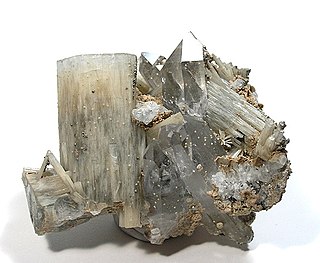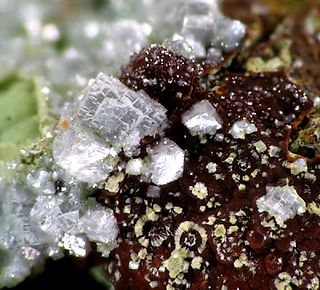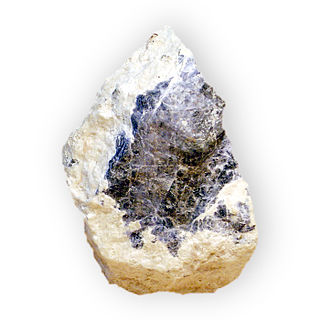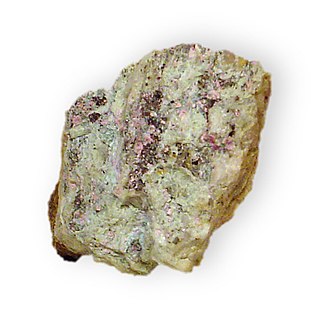Argentobaumhauerite (IMA symbol: Abha [1] ) is a rare mineral with the chemical formula Ag1.5Pb22As33.5S72. Its type locality is the Binn valley in Switzerland. [2]

Argentobaumhauerite (IMA symbol: Abha [1] ) is a rare mineral with the chemical formula Ag1.5Pb22As33.5S72. Its type locality is the Binn valley in Switzerland. [2]


Arsenopyrite is an iron arsenic sulfide (FeAsS). It is a hard metallic, opaque, steel grey to silver white mineral with a relatively high specific gravity of 6.1. When dissolved in nitric acid, it releases elemental sulfur. When arsenopyrite is heated, it produces sulfur and arsenic vapor. With 46% arsenic content, arsenopyrite, along with orpiment, is a principal ore of arsenic. When deposits of arsenopyrite become exposed to the atmosphere, the mineral slowly converts into iron arsenates. Arsenopyrite is generally an acid-consuming sulfide mineral, unlike iron pyrite which can lead to acid mine drainage.

Zinnwaldite, KLiFeAl(AlSi3)O10(OH,F)2, potassium lithium iron aluminium silicate hydroxide fluoride is a silicate mineral in the mica group. The IMA status is as a series between siderophyllite (KFe2Al(Al2Si2)O10(F,OH)2) and polylithionite (KLi2AlSi4O10(F,OH)2) and not considered a valid mineral species.

Otavite is a rare cadmium carbonate mineral with the formula CdCO3. Otavite crystallizes in the trigonal system and forms encrustations and small scalenohedral crystals that have a pearly to adamantine luster. The color is white to reddish to yellow brown. Its Mohs hardness is 3.5 to 4 and the specific gravity is 5.04. Associated minerals include azurite, calcite, malachite, and smithsonite.
Aeschynite-(Nd) is a rare earth mineral of neodymium, cerium, calcium, thorium, titanium, niobium, oxygen, and hydrogen with the chemical formula (Nd,Ce,Ca,Th)(Ti,Nb)2(O,OH)6. Its name comes from the Greek word for "shame". Its Mohs scale rating is 5 to 6. It is a member of the hydroxide minerals.

Cancrinite is a complex carbonate and silicate of sodium, calcium and aluminium with the formula Na6Ca2[(CO3)2|Al6Si6O24]·2H2O. It is classed as a member of the feldspathoid group of minerals; the alkali feldspars that are poor in silica. Yellow, orange, pink, white or even blue, it has a vitreous or pearly luster; a hardness of 5–6 and an uneven conchoidal fracture. It is unusual among the silicate minerals in that it will effervesce with hydrochloric acid due to the associated carbonate ions.

Chloritoid is a silicate mineral of metamorphic origin. It is an iron magnesium manganese alumino-silicate hydroxide with formula (Fe, Mg, Mn)
2Al
4Si
2O
10(OH)
4. It occurs as greenish grey to black platy micaceous crystals and foliated masses. Its Mohs hardness is 6.5, unusually high for a platy mineral, and it has a specific gravity of 3.52 to 3.57. It typically occurs in phyllites, schists and marbles.

Agrinierite (chemical formula K2(Ca,Sr)(UO2)3O3(OH)2·5H2O) is a mineral often found in the oxidation zone of uranium deposits. The IMA symbol is Agn. It is named for Henry Agrinier (1928–1971), an engineer for the Commissariat à l'Énergie Atomique.
Anandite is a rare phyllosilicate with formula (Ba,K)(Fe2+,Mg)3(Si,Al,Fe)4O10(S,OH)2. It crystallizes in the monoclinic crystal system. It is black in color with a glassy luster and a near perfect cleavage.
Brownleeite is a silicide mineral with chemical formula MnSi. It was discovered by researchers of the Johnson Space Center in Houston while analyzing the Pi Puppid particle shower of the comet 26P/Grigg-Skjellerup. The only other known natural manganese silicide is mavlyanovite, Mn5Si3.
Wassonite is an extremely rare titanium sulfide mineral with chemical formula TiS. Its discovery was announced in a 2011 NASA press release as a single small grain within an enstatite chondrite meteorite called "Yamato 691", which was found during a 1969 Japanese expedition to Antarctica. This grain represents the first observation in nature of the synthetic compound titanium(II) sulfide.

Strashimirite (IMA symbol: Ssh) is a rare monoclinic mineral containing arsenic, copper, hydrogen, and oxygen. It has the chemical formula Cu8(AsO4)4(OH)4·5(H2O).
Arakiite (IMA symbol: Ark) is a rare mineral with the formula (Zn,Mn2+)(Mn2+,Mg)12(Fe3+,Al)2(As3+O3)(As5+O4)2(OH)23. It is both arsenate and arsenite mineral, a combination that is rare in the world of minerals. Arakiite is stoichiometrically similar to hematolite. It is one of many rare minerals coming from the famous Långban manganese skarn deposit in Sweden. Other minerals bearing both arsenite and zinc include kraisslite and mcgovernite.
Ferraioloite is a rare mineral with formula MgMn2+4(Fe2+0.5Al0.5)4Zn4(PO4)8(OH)4(H2O)20. It is related to the phosphate mineral falsterite. Ferraioloite was found in pegmatites of the Foote Lithium Company Mine, Cleveland County, North Carolina, US. The name honors James (Jim) A. Ferraiolo (1947–2014).
Lislkirchnerite is a rare nitrate mineral with the formula Pb6Al(OH)8Cl2(NO3)5•2H2O. It was discovered in Nueva Esperanza No. 1 mine within the Capillitas deposit, Catamarca, Argentina.

Alpeite (IMA symbol: Apt) is a calcium manganese magnesium silicate mineral with the chemical formula Ca4Mn3+2Al2(Mn3+Mg)(SiO4)2(Si3O10)(V5+O4)(OH)6. It is named for its type locality, the Monte Alpe mine in Italy.

Alumohydrocalcite (IMA symbol: Ahcal) is a calcium aluminium carbonate mineral with the chemical formula CaAl2(CO3)2(OH)4·4H2O). Its type locality is Khakassia, Russia.

Anthoinite (IMA symbol: Atn) is an aluminium tungsten oxide mineral with the chemical formula AlWO3(OH)3. Its type locality is Maniema in the Democratic Republic of the Congo.

Alvanite is a zinc nickel aluminum vanadate mineral with the chemical formula (Zn,Ni)Al4(V5+O3)2(OH)12·2H2O. It was originally discovered in the Karatau Mountains.

Aramayoite is a mineral with the chemical formula Ag3Sb2(Bi,Sb)S6. Its type locality is Sud Chichas, Potosí, Bolivia.